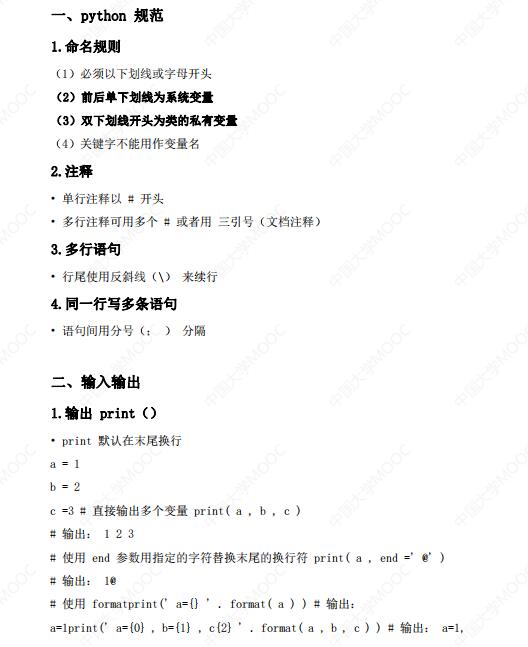
资料内容:
一、python 规范
1.命名规则
(1)必须以下划线或字母开头
(2)前后单下划线为系统变量
(3)双下划线开头为类的私有变量
(4)关键字不能用作变量名
2.注释
• 单行注释以 # 开头
• 多行注释可用多个 # 或者用 三引号(文档注释)
3.多行语句
• 行尾使用反斜线(\) 来续行
4.同一行写多条语句
• 语句间用分号(; ) 分隔
二、输入输出
1.输出 print()
• print 默认在末尾换行
a = 1
b = 2
c =3 # 直接输出多个变量 print( a , b , c )
# 输出: 1 2 3
# 使用 end 参数用指定的字符替换末尾的换行符 print( a , end =' @' )
# 输出: 1@
# 使用 formatprint(' a={} ' . format( a ) ) # 输出:
a=1print(' a={0} , b={1} , c{2} ' . format( a , b , c ) ) # 输出: a=1
b=2, c3
2.输入 input()
• input 输入的始终是字符串, 需要转换为其他数据类型使用
三、python 数据类型
1.六个标准数据类型
(1)Number(数字)
(2)String(字符串)
(3)List(列表)
(4)Tuple(元组)
(5)Sets(集合)
(6)Dictionary(字典)
2.Number
• 包括: int(整型) 、 float(浮点型) 、 bool(布尔型) 、 complex
(复数) 、 long(长整型)
• 清楚哪些值转换为布尔类型后值是 False
print(bool([]) )
# 输出: Falseprint(bool(' ' ) )
# 输出: Falseprint(bool({} ) )
# 输出: Falseprint(bool(() ) )
# 输出: False# 注意下面两个的区别
print(bool(0) )
# 输出: Falseprint(bool(' 0' ) )
# 输出: True
• 浮点数的内置函数运算会有误差, 也就是小数的精度问题
3.String
字符串属于序列, 除此之外还有:元组、列表(集合和字典不是序列类型)
单引号和双引号可以互换, 也可以互嵌
三引号表示多行字符串(也可以作为文档注释)
另外: 三引号内可以直接使用回车、 制表符, 可以不使用转移字符
来表示
字符串常用操作:
(1)连接和重复
print(‘hello’ *3, ’ wor’ +’ ld’ )
# 输出: hellohellohello world
字符串的切片(左闭右开)
word = ' hello world' print( word [0: 5])
# 输出: helloprint( word [: 5])
# 输出: helloprint( word [1: ])
# 输出: ello worldprint( word [: ])
# 输出: helloworldprint( word [0: 5: 2])
# 输出: hloprint( word [2: -2])
# 输出: lloworprint( word [-2: 2])
# 输出空串
(2)转义字符
• 要注意这种复杂的转义字符一起输出
在字符串内的“\r”、 ”\t”、 ”\n”等字符, 会转换为空白字符(回车符、
水平制表符、换行符……)
printf(' hello\tworld' ) # 输出: hello world
(3)Raw 字符串(字符串内不转义)
字符串前缀为’R’或‘r’
print(r‘hello\tworld’ ) # 输出: hello\tworld

